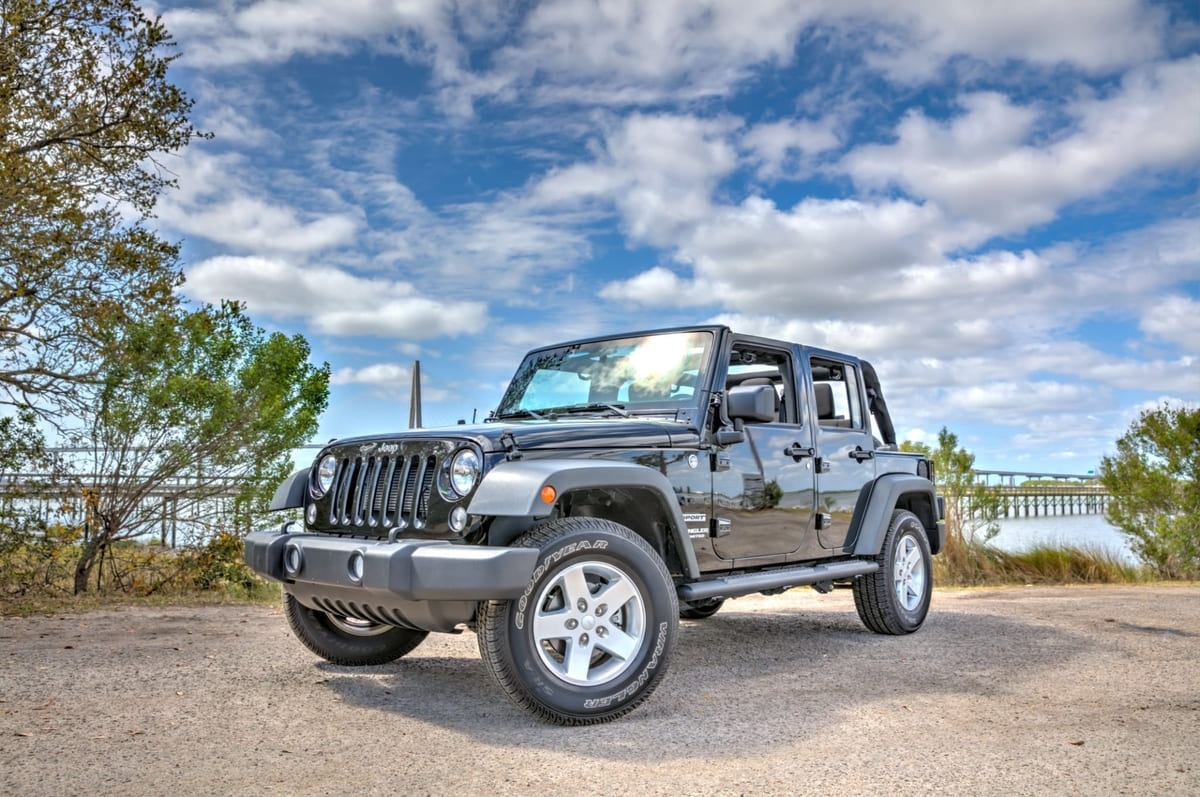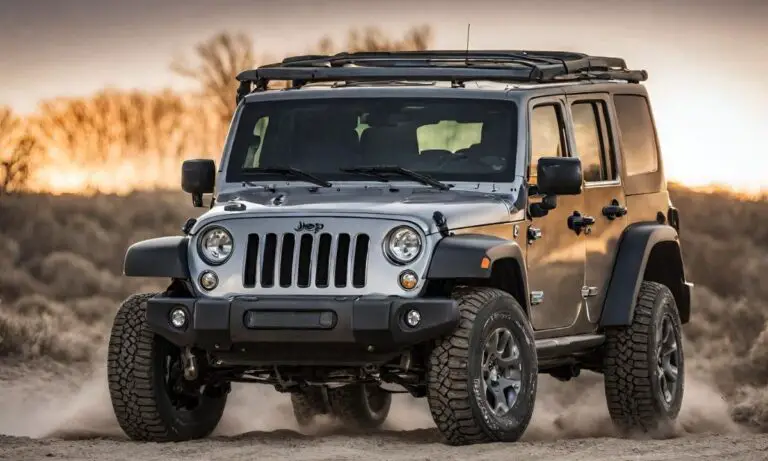Jeep Mastery Guide

Jeep is an American automotive company that specializes in Sport Utility Vehicles (SUVs). The name “Jeep” has become synonymous with rugged, versatile off-road vehicles. Jeep produces a range of SUVs and pickup trucks, from the compact Renegade to the full-size Grand Cherokee. Some key features of Jeeps include:
- Capability for off-road driving and rough terrain
- Sturdy build and durability
- Roomy interiors and ample cargo space
- Customization options and accessories
- Iconic, recognizable styling
Jeep has a long and storied history, dating back to WWII when the original Jeep was created as a light military vehicle. Over the decades, Jeep has evolved with new models and features but remains committed to adventure, freedom and capability. Jeeps continue to be popular for off-roading, outdoor sports, and everyday driving.
Table of Contents
History of Jeep
Origins in WWII
The origins of Jeep can be traced back to WWII and the U.S. Army’s need for a light reconnaissance vehicle. In 1940, the Army issued a bid for a vehicle that was lightweight, could climb steep hills and maneuver through mud, sand and snow. American Bantam was the first company to submit a prototype that met the Army’s criteria. This prototype was later improved upon by Willys-Overland and Ford, leading to the standardized military model known as the Willys MB.
The Willys MB, with its distinctive flat grille and boxy shape, was rugged, durable and versatile. It was dubbed the “Jeep,” a nickname that stuck. After WWII, Willys trademarked the Jeep name and began producing civilian models based on the MB. The CJ (Civilian Jeep) series launched in 1945 and quickly gained popularity as an agile utility vehicle well-suited for farming and recreation.
Growth and Evolution
In the following decades, Jeep continued to grow and evolve with changing tastes and demands. Important models included:
- Wagoneer (1963) – The first luxury 4×4, setting the stage for future family-oriented SUVs. Offered an automatic transmission and creature comforts.
- Cherokee (1974) – The 2-door sporty SUV that helped usher in the compact SUV craze. Known for its off-road prowess.
- Wrangler (1986) – Modern iteration of the CJ series, with a focus on off-road capability. Extremely customizable.
- Grand Cherokee (1993) – Jeep’s entrant into the full-size SUV segment. Premium features with impressive off-road ability. Huge sales success.
Jeep has changed ownership several times over the decades, being bought and sold between larger automakers like AMC and Chrysler. It is currently owned by the Stellantis auto group. Through all the changes, Jeep has stayed true to its identity as the definitive manufacturer of rugged, no-nonsense 4×4 vehicles.
Popular Jeep Models
Jeep currently produces five SUV/crossover models, ranging from compact to full-size. Here is an overview of today’s popular Jeep models:
1. Wrangler
The Wrangler is the modern iteration of the original WWII Jeep. It is the most capable and customizable Jeep model, optimized for serious off-roading.
Key features:
- Iconic Jeep styling: 7-slot grille, square headlights, open-air feel
- Body-on-frame construction
- Solid front and rear axles for superior articulation
- High ground clearance (up to 10.8 inches)
- Heavy-duty Dana axles
- Wide range of customization options
The Wrangler is available in 2- and 4-door versions. Trim levels include Sport, Sahara (luxury oriented), Rubicon (max off-road capability), and Mojave (desert racing-inspired). There is also a high-performance V8 Rubicon 392 model.
2. Gladiator
The Jeep Gladiator is Jeep’s pickup truck model, launched in 2020. It has a Wrangler-inspired design and chassis, but with a 5-foot truck bed. Like the Wrangler, it features body-on-frame build, solid axles, high ground clearance, and serious off-road capabilities.
Key features:
- Same Wrangler 4×4 systems and chassis
- Truck bed allows 5’x7′ cargo area
- Towing capacity up to 7,650 pounds
- Removable roof and doors on upper trims
- Optional forward-facing trail camera
The Gladiator comes in Sport, Overland and Rubicon trims. The Rubicon offers locking differentials, rock rails, Fox shocks and larger tires. A Mojave model is also available for high-speed desert driving.
3. Grand Cherokee
As Jeep’s most luxurious flagship SUV, the Grand Cherokee balances premium comfort and features with impressive off-road ability. It offers great on-road manners and long-distance cruising comfort.
Key features:
- Full-size SUV capability with available V8 power
- Quadra-Trac 4×4 systems
- Varied trim levels (Laredo to Summit)
- Plush, tech-filled cabin with available leather
- 140+ safety and tech features
- Towing capacity up to 7,200 pounds
The latest 5th generation Grand Cherokee adds more tech and refinement while retaining its rugged appeal. A new plug-in 4xe hybrid version is also available.
4. Cherokee
The Jeep Cherokee is a compact SUV that replaced the Liberty in Jeep’s lineup. It offers a good blend of cargo space, fuel efficiency and moderate off-road ability.
Key features:
- Compact SUV sizing (midsize interior space)
- Nuanced styling with signature 7-slot grille
- Grippy on- and off-road handling
- Good cargo room and towing ability
- Available V6 power and 4×4 systems
- High-tech options and safety features
The Cherokee comes in Latitude, Latitude Plus, Limited and Trailhawk trims. Trailhawk versions have improved approach angles, skid plates and Selec-Terrain traction management.
5. Compass
Jeep’s entry-level compact crossover SUV. The Compass offers Jeep styling, utility and available 4×4 in a city-friendly, fuel-efficient package.
Key features:
- Car-like maneuverability and parking ease
- Stylish interior with Uconnect infotainment
- Up to 30 mpg highway fuel economy
- Surprisingly capable 4×4 Trailhawk model
- Higher ground clearance than rivals
- Good passenger and cargo space
The Compass is aimed at urban commuters and young families looking for Jeep brand cachet. Trim levels range from Sport to Latitude, Limited and off-road-themed Trailhawk.
Jeep Brand Ethos and Ownership Experience
Jeep has cultivated a distinct identity and brand ethos centered around adventure, freedom, and self-expression. This resonates strongly with Jeep owners and fans.
Rugged Individualism
At the heart of the Jeep brand is rugged individualism – the desire to live freely without constraints. Jeep vehicles let owners customize their rigs to reflect their personality while going off the beaten path. Driving a decked-out Wrangler – top and doors off – lets you feel carefree and adventurous.
Capability Over Luxury
Unlike other SUV brands chasing luxury, Jeep focuses on utility and capability first and foremost. Trail-rated 4×4 systems, locking diffs, skid plates, tow hooks and aggressive tires enable owners to tackle tough terrain and challenges. Jeep capability breeds confidence to take roads less traveled.
Outdoor Adventure
Jeep is synonymous with outdoor adventure, from conquering rocky trails to camping trips into the wild. Jeeps have an intrepid spirit baked into their DNA. Models like the Wrangler and Gladiator provide rugged, go-anywhere transportation to access remote destinations and adventures.
Customization and Self-Expression
One of the joys of Jeep ownership is customizing your vehicle to match your personality. From immersive paint jobs to lift kits to high-gear crawl ratios, aftermarket parts let you tailor your Jeep. Badges and decals allow self-expression. The Jeep wave builds camaraderie among owners.
Fun-Loving Community
There is a palpable sense of community among Jeep owners. They tend to be free-spirited outdoor enthusiasts who enjoy pushing their Jeeps’ limits. Events like mud runs and off-road parks bring people together to celebrate Jeep culture. Owners find a shared mindset within the Jeep community.
Jeep Capability Systems and Off-Road Technology
A key reason people buy Jeeps is their legendary off-road capability. This is enabled by rugged hardware and advanced 4×4 systems engineered to conquer tough terrain.
4×4 Systems
All Jeep SUVs offer 4-wheel drive to send power to all four wheels. This improves traction in sand, mud and snow. There are two main Jeep 4×4 systems:
- Command-Trac: Part-time, shift-on-the-fly system. Rear wheels engage via transfer case.
- Selec-Trac/Selec-Terrain: Full-time 4WD system that automatically adjusts power distribution. Includes traction modes for different conditions.
Higher trims may also have limited-slip or locking differentials to prevent wheel spin and keep you moving.
Off-Road Tech and Hardware
Jeeps are packed with hardware and tech to boost off-road performance:
- Skid plates – Protect vital components like fuel tank from rocks and debris.
- Suspension – Features like solid Dana axles, long suspension travel and Fox shocks improve articulation and handling over rough terrain.
- Selec-Speed Control – Low-speed cruise control modulates throttle and braking for steadier rock crawling abilities.
- Tow hooks – Front and rear tow hooks allow you to be hauled out if stuck. Highly useful during recoveries.
- Hill Start/Descent – Brake assist features that provide control going up and down steep inclines.
Trail Rated Badge
Jeeps carrying the Trail Rated badge have passed tests in five key off-road areas: Traction, Ground Clearance, Maneuverability, Articulation and Water Fording. Trail Rated Jeeps like the Wrangler Rubicon and Cherokee Trailhawk excel off-road.
Jeep Brand Perception and Place in Culture
Beyond just being rugged SUVs, Jeep vehicles hold a unique place in American culture with symbolic meanings. The brand image carries perceptions related to freedom, authenticity and capability.
Symbol of Freedom and Patriotism
As the original WWII military vehicle, Jeep is entwined with ideas of duty and service. It’s a symbol of American patriotism and freedom. Driving a Jeep lets you feel a sense of independence and adventure. Open-air Jeep models connect you with the elements.
Authenticity
In an age of crossover look-alikes, Jeep has maintained distinct design cues for decades. The seven-slot grille and round headlights instantly identify a Jeep. This consistency gives the brand an aura of authenticity. Driving a Wrangler or Gladiator elicits a nostalgic, iconic feeling.
Capable and Trustworthy
Jeeps suggest that you’re capable of handling challenges on and off-road. The brand signals competence, ruggedness and preparedness for the unexpected. Jeep’s military history and engineering makes them vehicles you can rely on in any situation.
Cool Factor
There is an undeniable coolness associated with Jeep, especially models like the Wrangler. Driving one evokes a carefree, adventurous vibe. Jeeps have been featured prominently in movies for decades as “cool” vehicles. Rolling down the street in an open-top Wrangler garners attention.
Outdoor/Adventure Lifestyle
Jeeps are closely aligned with an active, outdoor lifestyle. They enable accessing surfing spots, climbing rocky cliffs to camp, or cruising across the dunes. Jeep taps into ideals of enjoying natural beauty and exploration. Owners tend to identify as outdoor enthusiasts.
Buying Considerations for Different Jeep Models
When buying a Jeep, you’ll want to consider factors like capability needs, passenger space, fuel efficiency, and intended use. Here are key considerations for popular models:
Wrangler
- How much off-roading and customization do you envision? The more extreme use, the higher spec (Rubicon) you may want.
- Do you require 4-door practicality or prefer classic 2-door style?
- Soft top or hard top? Determine how open you want the driving experience to be.
- Analyze how your mod plans (tires, lift kit, etc) might impact on-road manners.
Gladiator
- How much truck capability (towing/hauling) do you need? This guides choices like powertrain, axles, etc.
- Determine whether the bed length and storage are sufficient for your cargo needs. Open bed or tonneau cover?
- Assess lifestyle fit – does the adventure-oriented Gladiator align with how you plan to use it?
Grand Cherokee
- Match capability and luxury features to your budget. The higher the trim, the more luxe and tech-focused.
- Gauge whether you really need V8 power, or if a V6 provides enough performance.
- For family duty, verify rear seat room meets needs, and the cargo space fits strollers, sports gear, etc.
- If off-roading, consider augmenting 4×4 systems with options like locking diffs and skid plates.
Cherokee
- The Cherokee spans wider on-road (Latitude) to off-road (Trailhawk) ability. Choose where you land on that spectrum.
- 4-cylinder base engine delvers fuel economy; opt for the V6 for power. Choose drivetrain accordingly.
- Check latest tech features against rivals to determine if Cherokee keeps pace on infotainment and driver assists.
Compass
- As an entry model, the Compass comes well-equipped but has fewer options. Determine if you can live without add-ons.
- Test storage space and cabin room to make sure it can accommodate passengers and gear for daily use.
- Stick with FWD for maximum economy, or upgrade to 4×4 for inclement weather capability if needed.
- Understand it trails pricier Jeep models in off-road performance. Manage expectations accordingly.
Tips for Outfitting and Modifying Jeeps
One of the joys of Jeep ownership is customizing your rig through modifications and gear. Here are some tips:
Lift Kits
Adding a lift kit helps increase ground clearance for larger tires and serious off-roading. But don’t overdo lift height – 1.5 to 3 inches is often ideal for capability versus on-road handling.
Wheels and Tires
Opt for rugged all-terrain or mud-terrain tires for traction off-road. Match tire size carefully to intended use. Consider upgrading to heavier-duty alloy or steel wheels for stability.
Armor and Protection
Beef up vulnerable areas like bumpers, differential covers, control arms and transfer case with aftermarket armor. Rock rails and skid plates add vital protection from trail obstacles.
Lighting
Better lighting improves visibility on dark trails. Install auxiliary LED light bars and cube lights to illuminate the path ahead. Go for LED headlights and fog lights for clearer vision.
Winches and Recovery Gear
A sturdy winch lets you self-recover when stuck off-road. Combine with tree straps, shackles, hitches and a tow strap for extraction capabilities. Other key gear: gloves, tow hooks, jack.
Electrical System
Upgrade wiring, fuses, alternators and batteries to handle additional electrical load from mods like lights, winches and onboard gear. A dual battery setup prevents getting stranded out on the trails.
Storage and Cargo
Add protective cargo mats and liners to haul dirty gear. Install roof racks for extra cargo capacity outside the cabin. Pickup models benefit from bed covers and organizers to secure cargo during off-road driving.
Common Problems and Reliability Issues on Jeeps
While Jeeps are built rugged, they are not immune to problems. Being aware of common issues can help you evaluate used models and avoid headaches.
Leaking/Cracked Soft Tops
Laminated soft tops can leak at the seams or windows over time. Zippers also fail. Avoid too much sun exposure and use protectants to prolong top life. Factory tops tend to hold up better than aftermarket. Hard tops reduce leaks.
Overheating Issues
The Wrangler/Gladiator’s iconic grille design isn’t ideal for airflow. Upgraded radiators, fans, and hood vents can help manage engine heat. Keep the A/C condenser clean. Watch engine temps when wheeling on hot days.
Transmission Problems
Jeep’s automatics are not known for longevity, especially when subject to hard off-road use. Harsh downshifts, slipping and leaks are common by 100K+ miles. Proper maintenance and driving style helps prolong transmission life.
Rust Prone Body Panels
Poor drainage around windshields, rear frames, fender flares and rocker panels causes Jeep body rust over time. Touch up paint chips quickly to avoid future rust. Wash undersides regularly. Aftermarket protection products can limit rust issues.
Poor Gas Mileage
Aerodynamics and 4×4 drivetrains contribute to mediocre fuel economy, especially in the Wrangler and Gladiator. Real-world economy is often 2-3 mpg below estimates. You must accept compromise here. Light off-roading helps curb thirst.
Electrical Gremlins
Faulty window controls, radio glitches and wonky sensors point to flaky electrical components in some Wranglers. Check for TSBs on issues and inspect wiring harness, connectors and grounds for problems. The complex onboard electronics can prove finicky and troublesome.
Difficult Soft Top Operation
Over time, sagging fabric and plastic window distortion makes folding the soft top more difficult. Joints become less flexible as well in older tops. Maintain proper tension and lubricate zippers to avoid excessive force when opening/closing.
Steering Wander
The solid front axle on Wranglers and Gladiators – while great for articulation off-road – contributes to steering wander and looseness on-road. Upgraded stabilizer bars and steering dampers can tighten up feel. Proper alignment also crucial.
Clutch Wear
The clutch inevitably wears out faster with off-road use, given the heavy loads and high heat it endures. Learn to use low gears to limit slippage and ride the clutch lightly during technical sections. Expect more frequent clutch replacements if you off-road extensively.
Door Hinge/Latch Issues
The removable doors on Wranglers can sag over time, causing alignment and latch problems. Hinge bushings and pins wear down, requiring replacement. Lube hinge points and check latch adjustment regularly to avoid issues.
Oil Leaks
Frequent water submersion when off-roading exposes seals to contamination. Watch for leaks near gaskets, o-rings and block/head mating surfaces if you play in mud and streams. The 3.6L engine may leak near the rear main seal as well.
Wheel Bearing Failure
Premature wheel bearing failure plagues some Jeep models after 30K to 40K miles. This causes rumbling/grinding from the wheel hub. Most common on Grand Cherokees but an issue on Wranglers as well. Factory bearings seem prone to early wear.
Paint Fading
Due to thin paint or lack of UV clearcoat, some Jeep models suffer from quick paint fade and oxidation. This gives the paint a dull, chalky appearance that worsens yearly. More prevalent with lighter paint colors. Waxes and sealants help prolong a good shine.
Poor MPG from Lift Kits
Adding a suspension lift kit throws off the factory ride height and alignment, reducing aerodynamic efficiency. Taller tires also hurt fuel economy. A 2-3 inch lift cuts mpg by 1-2 combined. Not a deal breaker, but lift kits do sacrifice some efficiency.
Best Upgrades and Modifications
Picking the right upgrades and mods depends heavily on how you use your Jeep. Here are some of the best bang-for-buck improvements for different owners:
For the Off-Roader:
- Beefy off-road bumpers with winch mount
- Suspension lift kit to clear larger tires
- All-terrain or mud terrain tires for traction
- Aftermarket skid plates for vital component protection
- Rock sliders to prevent trail damage to rocker panels
- Front and rear locking differentials for max traction
For the Overlander:
- Roof top tent for camping adventures
- Onboard air compressor for airing down tires off-road
- Overland utility rack to hold gear and accessories
- All-terrain tires that balance road comfort and trail grip
- Upgraded high-output alternator to run accessories
- Interior storage solutions for on-board gear
For the Daily Driver:
- Cold air intake and performance tune for acceleration
- Soft top cleaner/protectant to keep top looking good
- Blind spot detection mirror for safety when changing lanes
- Phone mount for navigation and handsfree calls
- Premium speakers and subwoofer for tunes
- Running boards for easier vehicle access
For the Truck User:
- Hard tri-fold tonneau cover for secure bed storage
- Bed slide for easier access to rear cargo area
- Towing mirrors for visibility with trailers
- Heavy duty tow hitch receiver rated for max towing
- Gooseneck/5th wheel prep package for big tows
- Cargo tie downs and tailgate lock for gear security
Maintaining and Modifying Wranglers
The Wrangler is beloved for its endless customization options. Here are key maintenance tips and popular mods:
- Change trans fluid every 30K miles using correct spec fluid to prolong life
- Grease drive shaft u-joints before hitting trails to prevent vibrations
- Upgrade axle shafts on lifted Wranglers to handle larger tires and avoid breakage
- Re-torque suspension fasteners after heavy off-roading to avoid loosening parts
- Consider re-gearing diferentials when adding tires over 33″ to restore torque and acceleration
- Install fender flares to accommodate bigger tires and protect paint from debris
- Add CB radio for communication off-road with spotters and other vehicles
- Upgrade shocks & coils to fine tune suspension for desired wheel travel and ride quality
- Swap air intake to high-flow system like K&N to enhance power delivery and engine sound
- Add auxiliary switches to control accessories like lights, compressor, winch from dash
- Upgrade exhaust to performance system that adds power while enhancing the classic Jeep rumble
Jeep Culture and Community
Jeep owners share a sense of community rooted in adventure and a passion for off-roading. This culture is evident online and at in-person events.
Forums and Groups
Owners share experiences, mechanical advice, upgrade ideas, trip reports and more on forums like JeepForum.com. Facebook groups also connect local Jeepers looking to hit the trails together.
Meetups and Off-Road Parks
Clubs organize outings to legal off-road areas. Some parks offer challenging trails and obstacle courses for Jeeps to test their mettle. This draws enthusiasts together.
Events and Conventions
Large Jeep gatherings include Camp Jeep, Jeep Beach, Jeep Jamboree and Jeepstock. These festivals celebrate the lifestyle with trail rides, vendors, races, concerts and more.
Custom Builds
Dedicated owners spend huge amounts constructing custom rock crawlers, race Jeeps or overland rigs. The builds get showcased at SEMA and in magazines feeding the addictive hobby.
Jeep Wave
A friendly hand wave while passing a fellow Jeep on the road reinforces the sense of community. Even among strangers, the Jeep Wave brings an instant connection as part of the club.
Off-Road Mods
The quest to upgrade off-road performance fuels constant tinkering and modifications. Owners get ideas and pros/cons of different mods from fellow off-roaders online and in person.
Jeep’s Electric and Autonomous Future
As an historic brand, Jeep faces challenges adapting to emerging EV and self-driving technology while retaining its identity.
Wrangler/Gladiator EV
All-electric Wrangler and Gladiator models are coming by 2024. Removing the gas engine risks altering the character and capability Jeeps are known for. EV torque could improve off-road low-end control.
Grand Cherokee PHEV
The new 4xe plug-in hybrid Grand Cherokee promises 25 miles of electric range and 56 MPGe. This balances capability with eco-efficiency, but at a high cost. Will customers embrace the hybrid/EV shift?
Self-Driving Challenge
Can Jeep’s adventurous spirit be maintained with autonomous capability? The hands-free, eyes-free nature of full autonomy seems counter to Jeep’s engagement and active driving. Level 2 assistance may be the target.
Brand Dilution Risk
As Stellantis pushes Jeep into new segments like electrified crossovers, purists argue diluting the brand’s rugged image could alienate core off-road buyers looking for authentic 4x4s. Jeep must tread carefully.
Demand Decline
Jeep benefits from SUV sales momentum today. But EVs shift preferences and lower running costs may reduce demand for premium off-road SUVs. Jeep must keep attracting younger buyers as tastes evolve.
The path forward is filled with complex decisions for Jeep. Finding the right mix of capability, performance, tech and sustainability will shape if the brand continues thriving into its next 80 years.
Summary of Key Points
In this guide, we have covered:
- Origins of Jeep in WWII and evolution of iconic models like the Wrangler
- Overview of current Jeep lineup from Wrangler to Grand Cherokee
- Jeep 4×4 systems and off-road technologies enabling legendary capability
- Jeep’s brand ethos of freedom, adventure and ruggedness
- Buyer considerations for different Jeep models and use cases
- Community and culture around Jeep ownership and modification
- Reliability issues, common problems and best upgrades
- The future direction of Jeep with electric and autonomous vehicles
Jeep has built a reputation through 80 years of providing rugged, customizable 4x4s. As tastes change, the brand faces challenges to retain its heritage while evolving for a new era. But with its rich history and passionate fan base, Jeep remains one of the most recognizable automotive brands going forward.



![Granite Crystal Metallic Jeep [Review By Experts] Granite Crystal Metallic Jeep [Review By Experts]](https://automadesimply.com/wp-content/uploads/2022/10/granite-crystal-metallic-jeep-768x432.webp)



